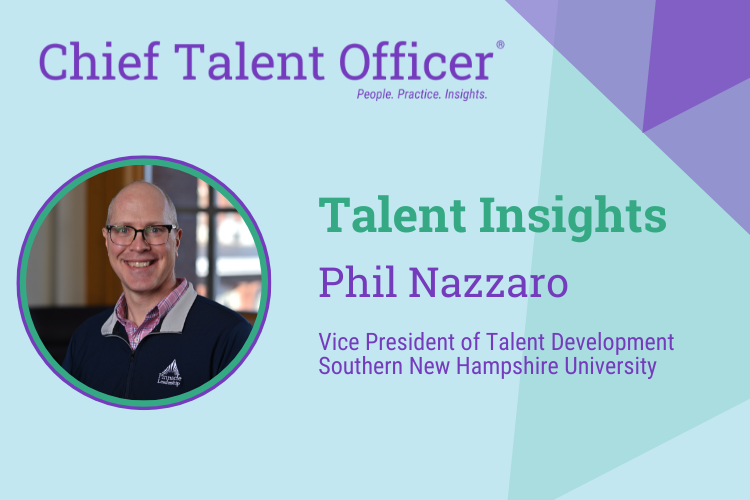Chief Talent Officer’s “Talent Insights” series is dedicated to sharing the insights and expertise of influential talent executives. In this Q&A series, we garner strategic insights, innovative approaches and challenges overcome from C-suite talent and HR executives, chief talent officers, chief people officers and more who are shaping the future of talent management.
What initially drew you to a career in talent management, and how have your experiences in the field evolved over the years?
I was initially drawn into the field through my passion for leadership and human development. Through my career thus far that passion has expanded and evolved through the development of programs and then organizational learning strategies to help not only people, but organizations, learn and grow. My perspective has also expanded beyond formal learning to how we harness and take advantage of the learning that happens every day across the organization – which is a current area of interest for me now.
What core values and principles do you believe are essential for building a positive and inclusive company culture?
We are in the midst of a multi-year effort to evolve our culture strategy to better align with and support our business strategy, so the concept of core values has been in the forefront of my mind for the last year. Values need to be authentic to an organization, so I hesitate to state ones that are specifically and universally essential to all. What I can say is that the values should have four aspects to them:
- They need to be purposefully derived – values are a tool to ensure a company is living the culture they desire to be. There are lots of positive values an organization can espouse, but to truly foster your desired culture they need to aggregate to guide decisions to build that culture in every interaction and how you go about your work.
- They need to be authentic – building off the first point, values need to be true to who you are as an organization. You can post values about equity and inclusion, but if as an organization you aren’t willing to make the systemic changes to advance these, the values quickly become lip service and performative.
- They need to be usable – overly complex and engineered value statements that aren’t quickly memorable and usable won’t get used. People are busier than ever and the ability to rapidly recall and put values to use in their day-to-day is essential to the values being able to form culture.
- They need to be human centered – the first three points are technical about values, this last point is more content focused and generalizable enough to be broadly applicable to any organization that wants to have a positive and inclusive culture, while still adhering to the first three points – they need to have people at their core. If a culture is meant to be truly inclusive and positive, people must be at the heart. Culture helps us understand how we get work done. If we don’t put people at the center of how we work together, the tasks and activities overwhelm the humans. That is where even authentically held desires of a more positive and inclusive culture will have great difficulty taking root.
“If a culture is meant to be truly inclusive and positive, people must be at the heart.”
Can you share a significant challenge you’ve faced as a talent leader and how you successfully navigated through it?
There are endless challenges in the role of talent leader. One that I’d categorize as a wicked problem is: How do we really demonstrate the value of the investment organizations make in learning? It isn’t just the cost of creating or purchasing learning, it is also the time people spend in learning experiences or activities that companies look at and leaders will rightly ask about. Learning is ultimately a cost center and without demonstrated impact and positive return, learning leaders, not just CFOs, should be asking about the value of the cost.
Like many, to work on this I’ve leveraged learning professionals with a penchant for data to help us try to build strategies to get Kirkpatrick’s level 3 and level 4 data, but this never got us any further than measures of central tendency and inferred correlations. In my latest role, I’ve gone another direction and brought in data scientists who don’t have learning experience and partnered them with leaders who have a deep understanding of learning design and built causational analysis-based models to get to data that accounts for all the extraneous factors and isolates the impact of the learning. Then we can do a return on investment analysis that has the necessary rigor to actually back up the claims the industry often makes about the impact of learning. We are early in our journey and there is a large amount of data that is necessary to get to reliable causational analysis, but we are well on our way and the early indications are incredibly exciting.
What strategies have you found most effective in attracting and retaining top talent in competitive industries?
I appreciate that the question on attracting and retaining are merged, as they are so interrelated. Any business has a value proposition you have to uphold for your customers – they need to feel that the value they are receiving for your good or service is achieved if you want them to remain a customer and/or advance your brand. It is the same with employees – the value they see in an organization when they are job searching and interviewing has to be met by their lived experience once on the team. Focus on what unique value you offer to employees, market that, and then live that in how you support employees. The specific strategies that you use will be based on who you are as a company and what your employee value proposition is. For the companies I’ve been in, I’d say it’s relentless focus on our mission, putting people first by having competitive pay and benefits, positive leadership practices, real honest and transparent growth and learning opportunities that have demonstrated positive impact on talent attraction and retention.
How do you balance advocating for employees’ needs while aligning with your company’s business objectives?
I don’t view employee needs and company business objectives as being an either/or situation. Ultimately a company’s value is brought to the customer and their business objectives are achieved through the employees. In this frame, supporting your employees is a critical component of achieving a company’s business objectives. Of course, company’s have limited resources; tailor what support you offer employees to meet their unique needs so they are engaged and happy. That positive sentiment gets carried forward to customers. The better a company can be in creating tailored support that meets employees’ personal needs rather than a catch all solution, the better that balance can be achieved.
What leadership skills do you prioritize and cultivate as a senior talent leader to inspire your team and drive talent initiatives?
Some of the most important skills to possess in the learning field are more in the affective domain than the cognitive one. We can train people to build effective learning and coach people to become strong facilitators, but there are some mindsets that are the most important to nurture in our learning professionals. These include deep curiosity, a radically growth oriented mindset, a test, learn, and scale approach to innovation, being invested and well-versed in the company’s business model, objectives and mission, consistently looking for novel approaches to our work and ensuring all that we create and do is learner-centric. Aligning on these mindsets and approaches allow us to empower and unleash the creativity and capabilities of our team to advance our work and the field as a whole.
What game-changing advice would you offer if you could go back in time and mentor your younger self?
Don’t wait until you have what you think the 100 percent solution will be to try something. Earlier in my career I wanted to get things just right and then rush to scale. I’ve learned that the real world doesn’t work that way and attempts to scale only work after trying imperfect ideas on small scales and learning and iterating.
What do you feel is currently the single biggest challenge facing talent professionals and the industry as a whole?
I will call it an opportunity rather than a challenge. Time has become a shrinking commodity as the pace of work, and life, has and continues to hasten. In this environment the time, or perceived time, people have to step away from work becomes less and less. We have attempted to mitigate that through micro-learning and saying it’s learning in the flow of work – but it is probably more correctly called stepping quickly out of the flow of work then back into it, rather than actually learning in the flow of work. The challenge and opportunity is for us as learning professionals to help people to learn how to learn as they work, to reflect during work and to be curious and willing to test and learn. If we can help people learn how to learn during work, we would be revolutionizing the field while addressing the challenge of time.
We’re always looking to showcase innovative tools and technologies. Can you share one tech product or platform that has significantly improved your work processes and why you find it valuable?
This is an opportunity area for us at the moment, especially as the technology landscape evolves so quickly. We are still leveraging an LMS as our means of distributing our learning. We have, however, worked to build microapp interfaces over the top of our LMS to vastly enhance the user experience. User experience is of paramount importance in the future of formal learning. We also have brought in a new PM tool (Asana – it isn’t new but it’s new to us) and that has definitely helped us with our internal processes to develop and deliver learning.
Interested in being featured in our “Talent Insights” series? Please complete this FORM.
















